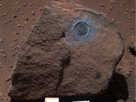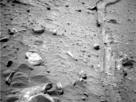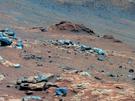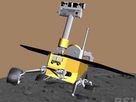NASA's Mars Reconnaissance Orbiter
Rover Will Spend 7th Birthday at Stadium-Size Crater
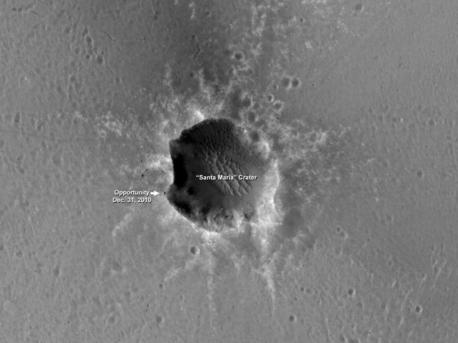 © NASA/JPL-Caltech/Univ. of Arizona
|
Opportunity is imaging the crater's interior to better reveal the geometry of rock layers as a means of defining the stratigraphy and the impact process. Santa Maria is a relatively young, 90-meter-diameter (295-foot-diameter) impact crater. Note the blocks of ejected material around the crater. It is old enough to collect sand dunes in its interior. Santa Maria crater, located in Meridiani Planum, is about 6 kilometers (4 miles) from the rim of the much larger Endeavour crater, Opportunity's long-term destination. The rim of Endeavour contains spectral indications of phyllosilicates, or clay bearing minerals believed to have formed in wet conditions that could have been more habitable than the later acidic conditions in which the sulfates Opportunity has been exploring formed. Data from the Compact Reconnaissance Imaging Spectrometer for Mars, which is also on the Mars Reconnaissance Orbiter, show indications of hydrated sulfates on the southeast edge of the Santa Maria crater. The rover team plans to use Opportunity to investigate that area through the solar conjunction period in late January and early February. During that period, Mars is almost directly behind the sun from Earth's perspective, and commanding from Earth to Mars spacecraft is restricted. After that, Opportunity will traverse to the northwest rim of Endeavour crater, aided tremendously by HiRISE images like this for navigation and targeting interesting smaller craters along the way.
Opportunity and its twin, Spirit, which passed its seventh anniversary on Mars this week, both have made important discoveries about wet environments on ancient Mars that may have been favorable for supporting microbial life.
NASA's Jet Propulsion Laboratory, a division of the California Institute of Technology in Pasadena, manages the Mars Reconnaissance Orbiter and Mars Exploration Rover projects for NASA's Science Mission Directorate, Washington. Lockheed Martin Space Systems, Denver, built the orbiter. The University of Arizona, Tucson, operates the HiRISE camera, which was built by Ball Aerospace & Technologies Corp., Boulder, Colo.
Source: Guy Webster (NASA)
NASA's Mars Reconnaissance Orbiter
Rover Will Spend 7th Birthday at Stadium-Size Crater
 © NASA/JPL-Caltech/Univ. of Arizona
|
Opportunity is imaging the crater's interior to better reveal the geometry of rock layers as a means of defining the stratigraphy and the impact process. Santa Maria is a relatively young, 90-meter-diameter (295-foot-diameter) impact crater. Note the blocks of ejected material around the crater. It is old enough to collect sand dunes in its interior. Santa Maria crater, located in Meridiani Planum, is about 6 kilometers (4 miles) from the rim of the much larger Endeavour crater, Opportunity's long-term destination. The rim of Endeavour contains spectral indications of phyllosilicates, or clay bearing minerals believed to have formed in wet conditions that could have been more habitable than the later acidic conditions in which the sulfates Opportunity has been exploring formed. Data from the Compact Reconnaissance Imaging Spectrometer for Mars, which is also on the Mars Reconnaissance Orbiter, show indications of hydrated sulfates on the southeast edge of the Santa Maria crater. The rover team plans to use Opportunity to investigate that area through the solar conjunction period in late January and early February. During that period, Mars is almost directly behind the sun from Earth's perspective, and commanding from Earth to Mars spacecraft is restricted. After that, Opportunity will traverse to the northwest rim of Endeavour crater, aided tremendously by HiRISE images like this for navigation and targeting interesting smaller craters along the way.
Opportunity and its twin, Spirit, which passed its seventh anniversary on Mars this week, both have made important discoveries about wet environments on ancient Mars that may have been favorable for supporting microbial life.
NASA's Jet Propulsion Laboratory, a division of the California Institute of Technology in Pasadena, manages the Mars Reconnaissance Orbiter and Mars Exploration Rover projects for NASA's Science Mission Directorate, Washington. Lockheed Martin Space Systems, Denver, built the orbiter. The University of Arizona, Tucson, operates the HiRISE camera, which was built by Ball Aerospace & Technologies Corp., Boulder, Colo.
Source: Guy Webster (NASA)





